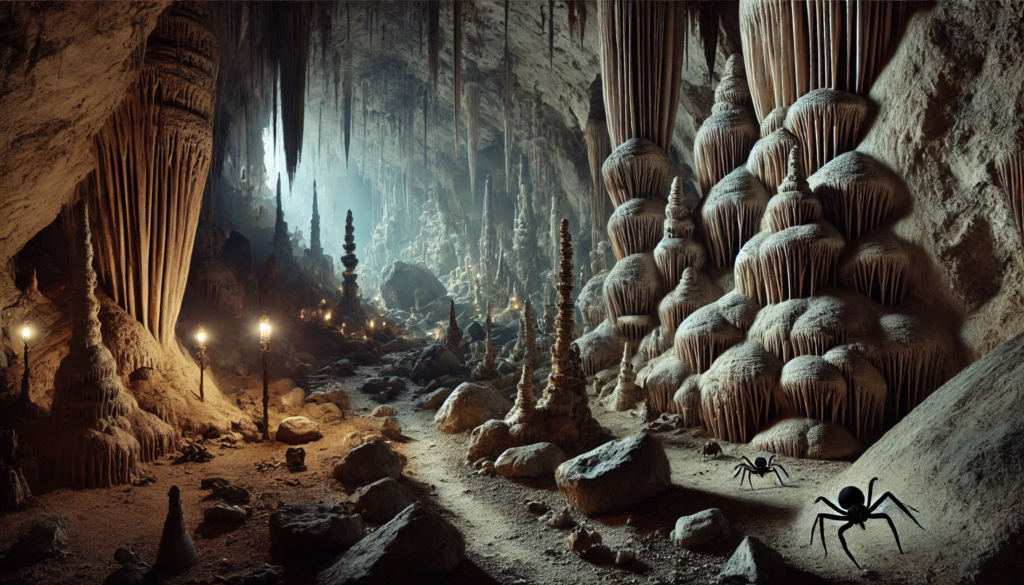The Caribbean is known for its sun-kissed beaches, tropical rainforests, and vibrant marine ecosystems. Yet beneath its surface lies another world, one far less explored but equally fascinating—the limestone caves that dot the islands. These subterranean realms are home to a unique and delicate ecosystem, harboring species adapted to life in darkness and isolation. From blind fish to elusive cave crabs, the biodiversity within Caribbean caves offers a window into an ancient and hidden world. In this article, we delve deep into the unique cave ecosystems of the Caribbean, exploring the species and environmental factors that shape these limestone caverns.
Formation of Caribbean Limestone Caves
Caribbean caves, primarily limestone caves, are formed through a geological process known as karstification. This occurs when slightly acidic rainwater, enriched with carbon dioxide from the atmosphere, percolates through the ground and dissolves the calcium carbonate in limestone. Over millennia, this process carves out complex networks of caves, caverns, and sinkholes. Many of these caves extend deep underground, with intricate formations such as stalactites and stalagmites decorating their interiors.
The Role of Water in Cave Formation
Limestone caves in the Caribbean owe their formation to the region’s tropical climate, which experiences heavy rainfall. As rainwater seeps into the porous limestone, it slowly erodes the rock, creating large caverns and chambers. These caves are often further expanded by underground rivers and streams that flow through them, continuing to sculpt the cave interiors.
In some cases, caves may be partially submerged in freshwater or saltwater, creating unique environments where marine and terrestrial ecosystems converge. Blue holes, deep vertical underwater caves, are common in the Bahamas and other parts of the Caribbean. These blue holes connect the surface with vast underwater cave networks, further expanding the range of cave ecosystems in the region.
Karst Topography and Its Importance
The development of karst topography in the Caribbean has led to the formation of extensive cave systems, sinkholes, and underground rivers. This topography is especially prominent in countries such as Puerto Rico, Cuba, and Jamaica, where limestone is the dominant rock type. Karst landscapes are not only significant for their geological beauty but also serve as crucial water reservoirs for the islands. These underground aquifers supply fresh water to communities and support various forms of wildlife, both within and outside the caves.
Cave Ecosystems: Life in Darkness
Life inside Caribbean limestone caves is a testament to the resilience of species that have adapted to extreme and isolated environments. Cave ecosystems are often described as oligotrophic, meaning they are nutrient-poor. With little light and minimal food sources, cave-dwelling species have evolved to survive in conditions that would be inhospitable to most other forms of life.
Adaptations of Cave Species
Cave-dwelling organisms, or troglobites, display remarkable adaptations that allow them to thrive in darkness. One of the most common adaptations is the loss of eyesight. In the absence of light, vision becomes unnecessary, and many cave species, such as blind fish and crustaceans, have evolved without functioning eyes. Instead, they rely on other senses, such as touch and smell, to navigate and find food.
Other adaptations include reduced pigmentation, as there is no need for camouflage in a lightless environment, and elongated appendages, which help species move through narrow crevices and catch prey. These evolutionary changes have allowed a wide variety of species to colonize cave ecosystems, despite the challenges posed by their environment.
Energy Sources in Caves
Unlike most ecosystems that rely on sunlight for energy through photosynthesis, cave ecosystems are largely chemosynthetic or reliant on energy sources brought in from outside the cave. Organic material, such as dead leaves, animal carcasses, or guano (bat droppings), often serves as the primary energy source in caves. This material is broken down by bacteria and fungi, which in turn provide nutrients for other organisms within the cave food web.
In some underwater caves, especially those connected to the ocean, nutrients may be introduced by tidal flows, creating a more diverse range of food sources. These caves often host marine species, such as shrimp and crabs, that have adapted to the dark, nutrient-scarce environment.
Unique Species Found in Caribbean Caves
Caribbean limestone caves are home to a variety of unique and often endemic species that cannot be found anywhere else. These species have evolved to survive in the isolated and extreme conditions of cave ecosystems, making them particularly fascinating to biologists and conservationists.
Bats: Guardians of the Cave Ecosystem
Bats are perhaps the most iconic inhabitants of Caribbean caves. Many species of bats use caves as roosting sites, where they rest during the day before venturing out at night to hunt for insects, fruit, or nectar. In addition to playing a crucial role in controlling insect populations, bats are also vital to the cave ecosystem itself.
Bat guano provides a rich source of nutrients for many cave-dwelling organisms, from fungi and bacteria to invertebrates such as beetles and crabs. The presence of bats in a cave can significantly enhance the biodiversity within the cave ecosystem by introducing a steady supply of organic material.
Some of the notable bat species in Caribbean caves include the Jamaican fruit bat (Artibeus jamaicensis) and the Cuban flower bat (Phyllonycteris poeyi). These bats play an important ecological role, not only in the cave ecosystem but also in pollination and seed dispersal in the surrounding environment.
Cave Crabs and Shrimp
Cave crabs, particularly the white cave crab (Munidopsis polymorpha), are among the most striking examples of cave-adapted fauna in the Caribbean. These crabs are completely blind and have evolved to navigate their environment using highly sensitive antennae. Found primarily in the blue holes and underwater caves of the Bahamas and Cuba, these crabs rely on chemosensory cues to find food.
Similarly, cave shrimp, such as the Bahamas cave shrimp (Typhlatya garciai), have adapted to life in total darkness. These shrimp are often found in submerged caves where they feed on detritus brought in by water currents. Their pale, translucent bodies are a hallmark of species that have adapted to life in lightless environments.
Blind Fish
Blind fish are another remarkable example of adaptation to cave life. The Cuban blind cave fish (Lucifuga subterranea) is a species that has lost its eyesight over generations of living in dark cave environments. These fish rely on enhanced sensory organs to detect vibrations and chemical signals in the water, allowing them to locate prey and avoid obstacles.
Blind cave fish are typically found in submerged limestone caves and sinkholes, where they feed on small invertebrates and organic matter carried in by water currents. The loss of vision and pigmentation is an evolutionary trade-off that has allowed these fish to thrive in an environment where light is non-existent.
Spiders and Insects
Caves in the Caribbean are also home to a variety of cave-dwelling spiders and insects, many of which are highly specialized for life in dark, humid environments. Cave spiders, such as species in the family Pholcidae, are known for their elongated legs and ability to build webs in narrow crevices. These spiders prey on small insects and other invertebrates that wander into their webs.
Cave-dwelling insects, such as beetles and crickets, often feed on bat guano and decaying organic material. These insects play a crucial role in breaking down organic matter and recycling nutrients within the cave ecosystem.
Endemic Species and Conservation
Many species found in Caribbean caves are endemic, meaning they are found nowhere else on Earth. This makes these caves critically important for biodiversity conservation. However, cave ecosystems are highly vulnerable to disturbances such as pollution, habitat destruction, and human activity. The isolation of cave species also makes them particularly sensitive to changes in their environment, as they have evolved to survive under very specific conditions.
Conservation efforts aimed at protecting these unique cave ecosystems are crucial to preserving the biodiversity they support. In some areas, caves have been designated as protected sites, and research is ongoing to better understand the ecological dynamics within these hidden environments.
The Role of Caves in Caribbean Culture
Caves in the Caribbean are not only important from an ecological perspective but also hold significant cultural and historical value. Many caves have been used by indigenous peoples for ceremonial purposes, as burial sites, or as shelters. In countries such as the Dominican Republic and Puerto Rico, cave art and artifacts provide valuable insights into the lives of the region’s early inhabitants.
Today, caves continue to be important cultural and tourism sites. Ecotourism focused on cave exploration, such as spelunking and guided tours of limestone caves, has become a popular activity in the Caribbean. However, the growing popularity of cave tourism also presents challenges, as increased human activity can damage delicate cave ecosystems. Ensuring that tourism is conducted sustainably is essential to protecting these unique environments for future generations.
Conclusion
The limestone caves of the Caribbean are home to some of the most unique and specialized ecosystems in the world. These dark, isolated environments have fostered the evolution of species that are perfectly adapted to life in extreme conditions, from blind fish and crabs to bats and cave-dwelling insects. The biodiversity within these caves is not only fascinating but also crucial to the ecological balance of the region.
As we continue to explore and understand these hidden worlds, it is vital that we also take steps to protect them. Conservation efforts, sustainable tourism, and ongoing research are all essential to preserving the delicate ecosystems within Caribbean caves, ensuring that their unique fauna can thrive for generations to come.
FAQ
What are limestone caves, and how do they form?
Limestone caves are formed through a process called karstification, where slightly acidic rainwater dissolves limestone over time, creating underground chambers, caverns, and tunnels. This process can take thousands or even millions of years, resulting in complex cave systems.
What animals live in Caribbean caves?
Caribbean caves are home to a variety of unique species, including bats, blind cave fish, cave crabs, shrimp, spiders, and insects. Many of these species have evolved specific adaptations to survive in dark, nutrient-poor environments.
How do cave species survive without sunlight?
Cave ecosystems rely on alternative energy sources, such as organic matter brought in from outside the cave or guano from bats. Many cave species have adapted to survive in darkness by developing enhanced senses, such as touch or smell, and losing unnecessary traits like eyesight.
Why are Caribbean caves important for biodiversity?
Caribbean caves are home to many endemic species that cannot be found anywhere else in the world. These ecosystems provide critical habitats for specialized organisms, making them essential for biodiversity conservation.
Can humans visit Caribbean caves?
Yes, many Caribbean caves are open to visitors for guided tours or ecotourism activities such as spelunking. However, it is important that cave tourism is conducted sustainably to avoid damaging fragile ecosystems.
How do bats contribute to cave ecosystems?
Bats play a crucial role in cave ecosystems by introducing nutrients in the form of guano, which supports a wide range of organisms. Bat colonies also help control insect populations outside the cave, contributing to the overall health of the ecosystem.

